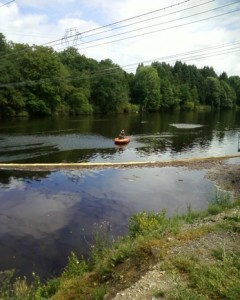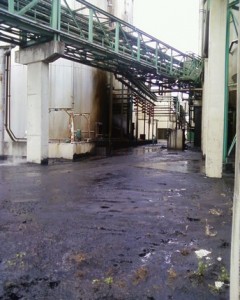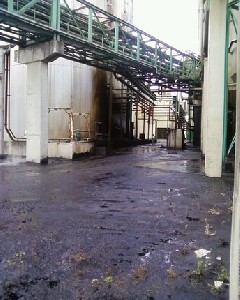In a paper mill, the cone-shaped bottom on a black liquor storage tank (with pH 13) experienced mechanical failure at 8:47 am. When the incident occurred, this 600-m³ capacity tank was holding 500 m³ of liquor which drained in less than 30 s. The effluent was partially confined within its assigned retention zone, accounting for 100 to 120 m³; another 300 m³ of the substance was channelled to a treatment pond, while 80 to 100 m³ reached the VIENNE River via the plant’s storm drain network between 8:50 and 10:30 am.
Fire-fighters installed floating booms in several places and observed foam formation extending 500 m long and 80 m wide around the village of Chabanais. No fish deaths were reported in the VIENNE. The Prefecture cautioned against swimming, fishing, farm irrigation and any navigation on the VIENNE downstream of the pollution release zone for the entire weekend. Plant officials issued a press release regarding the accident. An environmental quality monitoring campaign was implemented by the site operator. At three measurement points located 500 m, 2 km and 7 km downstream of this discharge, pH, conductivity, COD and dissolved oxygen parameters were recorded. Geographic tracking of the pollution path was also performed twice a day. In terms of economic impact, the costs of production shutdown and cleanup were estimated at 2 million.
The site’s safety report (produced in 2009) discussed 2 accident scenarios capable of occurring with respect to liquor regeneration, the first pertaining to an explosion of the boiler itself and the other to an explosion of its dissolver, yet the report did not study a scenario resembling the actual accident. Moreover, the retention facility, located beneath the damaged workshop’s 8 tanks, seems to have been designed in such a way that it failed to comply with regulations. On 8th July, the Prefect signed an emergency stop order intended to:
- supervise the service restart protocol, on condition of completion of a number of steps (recertification and repairs to equipment such as electrical installations, valves, emergency shutdown devices, tanks similar to the one involved in the accident, update of procedures, structural work, etc.);
- closely monitor the local environment (pH, dissolved oxygen) until the end of cleanup and installation renovation phases;
- remove waste generated by the accident to appropriate authorised facilities.
Subsequent to cleanup, repairs and inspection, the plant restarted according to an incremental schedule (excluding the damaged workshop). The black liquor recovered on-site during cleanup operations was reinserted into plant installations following in situ pre-treatment.
Rupture of the tank’s cone-shaped bottom, where black liquor was being extracted, could be ascribed to gradual wear caused by corrosion/erosion. Built with carbon steel in 1988, the tank had been inspected in situ in 1998 by a certified body; the ensuing report led to repairing the sheet metal composing the cone-shaped bottom by adding another layer and then inspecting the set of welds by means of dye penetrant testing. The appraisal carried out in August 2011 indicated that after the 1998 repairs, one or more black liquor infiltrations had occurred between the original sheet metal and the additional layer. This phenomenon had drastically accelerated corrosion of the second layer of metal plates and kept corroding the original tank wall as well.
Given the identified corrosion characteristics along with the remedial solutions introduced in 1998, the tank bottom was considered to be protected from any eventual corrosion problem, an assessment which seemed justified as, until the incident, none of the monthly external inspections had revealed any precursor signs.
Moreover, the tank’s raised position, coupled with a layout (designed for very tall – 21 m – storage) featuring an apron open at its base and then the sudden failure of the cone-shaped bottom causing black liquor to vaporise, all contributed to spraying a portion of the liquor (so-called “jet effect”) beyond the retention pit. The location of this tank, at the border of the evaporation unit retention pit, served to heighten this “jet effect” and increase the quantity of black liquor ejected outside the retention zone.
An analysis of this incident led the DREAL (Environmental Protection Agency) to request the plant operator to speed up the storage tank inspection campaign and further improve site maintenance procedures.
Download the detailed report in .pdf format (272 Kb)






